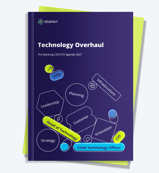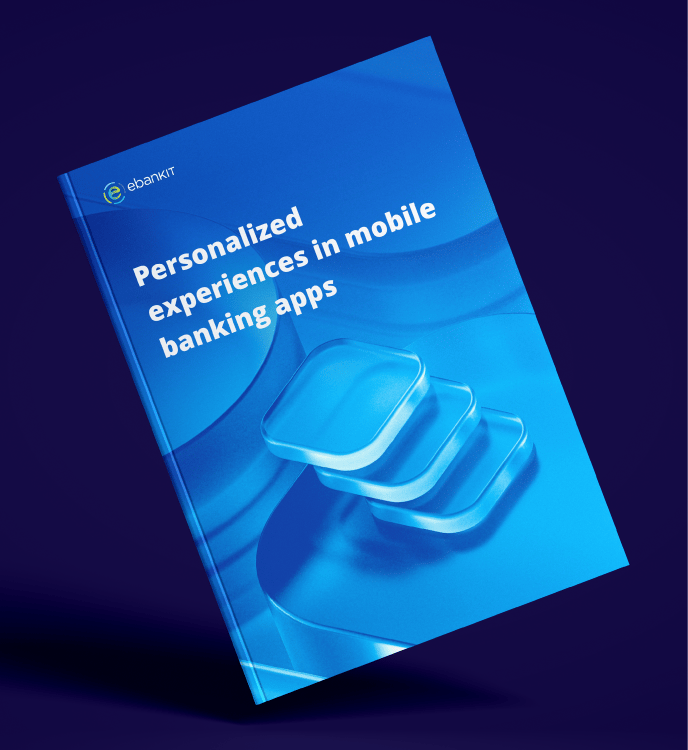Innovation in Action: Digital Strategies to Drive Small Business Prosperity
Recorded on 23 September, 2025



SPEAKERS
Paul Provenzano, ebankIT
Dixi Berrios, Metropolitan Commercial Bank
Vidya Vishal, Barlow Research Associates
SUMMARY
Discover leading-edge digital strategies that empower small businesses to thrive in today’s competitive landscape and how their financial institution can serve as a trusted business partner. This webinar explores how innovation in banking and payment solutions can drive efficiency, enhance financial management and accelerate business growth, all while creating loyalty and driving revenue for the financial institution.
Key topics
Tailor digital experiences for SMB clients to ensure seamless interactions across digital channels, supported by a robust technology stack.
Smartphone-driven business owners need a unified platform that is simple to use and accessible, and offers all banking services through a single login.
Find the right balance between automation and human connection. Customers want digital options but also easy access to human support if needed.
Transcript
00:00:00 - Introduction and line-up for the session
The webinar introduces leading-edge digital strategies aimed at empowering small businesses and positioning financial institutions as trusted partners. Hosted by Katherine Tracy, the session features insights from Dixie Berios of Metropolitan Commercial Bank, Paul Provenzano of ebankit, and Vidya Vashal of Barlow Research. It explores how innovation in banking and payment solutions can enhance efficiency, financial management, and growth for small businesses, while also fostering loyalty and revenue for banks. Metropolitan Commercial Bank is highlighted as a community-focused institution undergoing digital transformation to better serve small and mid-sized businesses. Vidya shares research showing that small businesses are optimistic yet face evolving financial needs, presenting opportunities for community banks to deepen relationships through personalized, digital-first services.
00:05:00 - Market Research
The webinar begins by emphasizing the growing importance of supporting the small business community, especially through community banks and financial institutions. The speaker highlights that recent market research has revealed a consistent trend: small businesses are underserved and unaware of the services available to them.
Market research is driving the conversation around small business support. A Forbes study says that 45% of small business owners are unaware of their financial institution’s offerings. Frontiers Systematic Review (May 2025) highlighted that Small business owners prioritize digital banking capabilities, service quality, and competitive pricing when choosing financial institutions. There’s a clear opportunity for financial institutions to better serve and retain small business clients through innovation and improved communication.
00:10:00 - Undergoing a digital transformation
Metropolitan Commercial Bank is undergoing a digital transformation centered on personalizing the customer journey. Dixie Berios explains that the bank is segmenting its customer base to tailor digital experiences for small, midsize, and commercial clients. The goal is to ensure seamless, relationship-driven interactions across digital channels, supported by a robust technology stack. Vidia Vashal adds that digital banking adoption is rising, with nearly 80% of small businesses using online banking and over half using mobile banking. Younger, digital-native business owners are accelerating this trend. She emphasizes that digital capabilities now influence primary banking relationships, with 33% of small businesses willing to switch banks for a better online experience. However, cybersecurity concerns remain a major barrier to full adoption. Dixie reinforces the importance of a unified platform that offers all banking services through a single login, aligning with customer expectations for simplicity and accessibility.
00:15:00 - Mobile-first approach
Metropolitan Commercial Bank is prioritizing a mobile-first approach to futureproof its technology stack, recognizing that traditional banking platforms are no longer sufficient for younger, smartphone-driven business owners.
The bank is also enhancing its payment capabilities, including support for FedNow and real-time payments (RTP), to meet the transactional needs of small and midsize businesses. A major focus is on risk management, especially in light of evolving fraud threats enabled by AI.
The bank is integrating advanced fraud prevention tools to ensure a secure yet frictionless customer experience. In response to a question about non-traditional services, Dixie highlights the importance of accessibility and embedded banking—offering services via APIs and webhooks that integrate directly into clients’ platforms.
This allows businesses to manage banking tasks like reconciliation and accounting without leaving their own systems. Vidia adds that small businesses increasingly expect financial institutions to go beyond basic services, offering innovative, embedded solutions that align with their operational workflows.
00:20:00 - Technology expanding traditional banking services
Vidia highlights how technology is expanding traditional banking services, especially in lending. With improved AI, machine learning, and access to alternative data, banks can now approve more small business loans that previously would have been declined due to strict risk standards.
This shift allows financial institutions to reclaim lending activity from alternative lenders. She also emphasizes the importance of digital payments, noting that partnerships with third-party providers (like payroll services or payment platforms) are helping banks offer seamless, integrated experiences.
Another growing trend is the use of data analytics to gain a holistic view of a business’s operations, enabling banks to offer more personalized advice. Vidia then transitions to operational efficiency, explaining that small businesses want tools that simplify routine tasks.
Examples include assigning authorized users with custom permissions, scheduling recurring payments, and using tap-to-pay or embedded payment links. These innovations reduce friction and improve both business and customer experiences. Finally, banks are investing in tools that go beyond transactions to support better financial decision-making, reinforcing their role as strategic partners.
00:25:00 - Becoming an active financial partner
New digital tools, such as cash flow forecasting and budgeting, are helping small business owners gain a clearer understanding of their financial future.
These features allow users to track inflows and outflows, model scenarios, set spending limits, and establish savings goals—transforming banks into active financial partners rather than passive service providers.
Dixi from Metropolitan Commercial Bank emphasizes that while digital self-service capabilities are growing, relationship banking remains central to their approach. The bank uses customer data to proactively engage clients, offering personalized outreach and guidance based on transaction patterns. For example, noticing a large transfer might prompt a banker to offer mortgage support or future planning advice.
This blend of digital efficiency and human connection allows the bank to maintain trust and deepen relationships. Vidia adds that personalization is key to driving loyalty and engagement, and Barlo’s research confirms that small businesses still value human interaction, even as digital tools become more prevalent.
00:30:00 - SMB customers value their relationship with their banker
Barlow Research finds that small business customers value their relationship with their banker as much as the products and services offered. Digital platforms are enhancing, not replacing, these relationships by enabling live chat, video calls, and appointment scheduling, which deepen engagement.
Medium-sized bank customers are twice as likely as those at larger banks to seek advice from their banker, especially on reducing expenses, credit guidance, and automation solutions. The speaker emphasizes that understanding a business’s cash flow and operational needs is key to strengthening relationships.
The conversation then shifts to the fintech ecosystem, where the speaker explains that while fintechs are agile and innovative, banks have the advantage of trusted, long-term relationships. Strategic partnerships between banks and fintechs can deliver modern, seamless experiences by combining strengths. However, financial institutions must first understand their customer base through listening programs and segmentation, ensuring that fintech integrations are aligned with client needs. These collaborations can accelerate innovation, expand offerings, and enhance competitiveness in a rapidly evolving digital landscape.
00:35:00 - Successful fintech partnerships
Vidia emphasizes that successful fintech partnerships go beyond technology—they require a shared vision, long-term value, and cultural fit.
Dixie explains how Metropolitan Commercial Bank evaluates third-party solutions by first understanding its customer segments and listening to their needs. Rather than chasing trends or reacting to competitors, the bank aims to be proactive and first-to-market with solutions that genuinely serve its clients. She stresses the importance of aligning fintech partnerships with the bank’s strategic goals and recognizing that not every solution fits every customer.
The bank focuses on building customer success plans for each vertical and seeks partnerships that enhance profitability and service quality.
Vidia adds that measuring success is crucial. One key metric for medium-sized banks is market share, which they currently hold, about a quarter of the small and medium business market. This sets the stage for further discussion on KPIs and ROI in digital strategy.
00:40:00 - Measuring success in digital banking
Vidia explains that medium-sized banks currently hold about 25% of the small and medium business market, and their share is expected to grow, especially among more established businesses seeking expanded services.
A 14-point increase in market share over the past decade signals strong momentum. She emphasizes that market share growth is a key indicator of digital transformation success, alongside internal metrics like digital engagement and adoption rates. Without sufficient usage, ROI is difficult to achieve.
Dixie adds that Metropolitan Commercial Bank tracks both financial and non-financial KPIs, including deposit growth, cost per transaction (branch vs. digital), Net Promoter Score (NPS), login frequency, feature adoption, call center volume, transaction completion rates, and fraud detection effectiveness.
The conversation then shifts to the role of physical branches in non-transactional interactions. Dixie notes that while some foot traffic remains, especially among certain customer segments, most small businesses now prefer digital channels for consultative services, highlighting a shift toward convenience and efficiency.
00:45:00 - Digital convenience with human connection
Small business owners increasingly prefer non-branch channels such as phone, live chat, and co-browsing, for non-transactional interactions like financial planning and product guidance. Time constraints make it difficult for many to visit branches, so offering flexible digital options is essential.
However, some business owners still value in-person branch visits, especially for deeper consultations, showing that both digital and physical channels must coexist. AI-powered tools like chatbots are improving interactivity, but must be balanced with human support to avoid frustration during complex issues. Looking ahead, Dixie predicts that embedded finance and open banking will become more prominent, allowing banks to integrate their services directly into small business platforms.
Vidia adds that trust and reliability remain key, with 47% of midsize banking customers confident their bank will support them during tough times—highlighting the importance of maintaining strong relationships alongside digital innovation.
00:50:00 - Building trust through humanized digital touchpoints
Small business owners who trust their banks expect proactive guidance and personalized experiences, especially as 43% anticipate an ownership transition in the near future.
With many current owners in their mid-50s, banks have a strategic opportunity to support succession planning, onboard new owners, and strengthen engagement early to prevent attrition. Vidia and Dixie emphasize that relationship-building remains essential, even as digital platforms evolve.
Pain points in digital banking include clunky interfaces, low trust in mobile payments, and a lack of education on using digital tools safely. Customers want digital options, but also need easy access to human support, especially during complex issues.
The key is finding the right balance between automation and personal connection, ensuring that digital tools enhance—not replace—the relationship.
00:55:00 - Seamless onboarding, smart security, and expanding value
Dixie emphasizes the importance of a seamless onboarding experience, noting that if a small business customer encounters friction during account setup or digital access, it can negatively shape the entire relationship. Security remains a top priority, with features like step-up authentication and out-of-band verification helping protect transactions without disrupting the user experience.
Paul highlights that the ebankit platform supports a wide range of business account structures, including multi-tiered organizations, with features like multicurrency, multilingual support, and open API integration for fintech partnerships.
The discussion then shifts to how banks can expand beyond traditional banking by offering value-added services such as merchant solutions, using customer data to tailor offerings and deepen relationships.
Data also enables benchmarking, which is especially valuable for first-time business owners seeking guidance. The webinar concludes by reinforcing the idea that community banks and credit unions are well-positioned to become trusted financial partners, combining digital innovation with strong personal relationships.




%20without%20SAM%20-%20Maturity%20Level%20-%202-KO%20edit.webp?width=160&height=57&name=67768-ebankIT%20Platform%20-%20CMMI%20Development%20V2.0%20(CMMI-DEV)%20without%20SAM%20-%20Maturity%20Level%20-%202-KO%20edit.webp)
